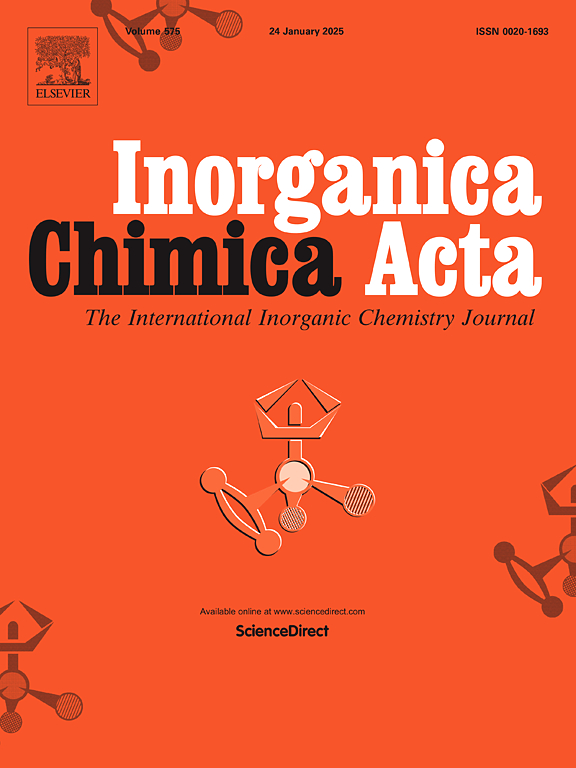Rhenium (I) complexes based on iminopyridyl ligands: Structural, photophysical, and CO2 electrocatalytic reduction studies
IF 3.2
3区 化学
Q2 CHEMISTRY, INORGANIC & NUCLEAR
引用次数: 0
Abstract
Five rhenium complexes [Re(CO)3(N,N)Cl] (C1–5), in which N,N represents iminopyridyl ligands, were successfully synthesized. The structural characterization of these compounds includes NMR, FT-IR, and HRMS analyses. Additionally, the molecular structures of C2 and C3 were determined through X-ray diffraction analysis. Electrochemical characterization indicates a metal-centered HOMO and a ligand-centered LUMO, with the latter strongly influenced by the nature of the substituent. The photophysical properties of all complexes were examined using UV–Vis spectroscopy and spectrofluorometric measurements in dichloromethane solution at room temperature, as well as in the solid state. All complexes exhibit a spin-allowed MLCT absorption transition in the 405–471 nm range. In degassed dichloromethane solution at room temperature, complexes C1–3 and C5 display an unstructured (Kinzel et al., 20213)MLCT emission in the red region of the visible spectrum. In contrast, complex C4, which features the lower-energy absorption, is nearly non-luminescent. Conversely, all complexes show emission in the solid state, with bands presenting a distinctive hypsochromic shift characteristic of MLCT states. Finally, all compounds were evaluated for their ability to promote the electrocatalytic reduction of CO2, showing turnover frequencies (TOFs) ranging from 8.1 to 304.4 s−1.

基于亚氨基吡啶配体的铼(I)配合物:结构、光物理和CO2电催化还原研究
以N,N为亚氨基吡啶配体,成功合成了5种铼配合物[Re(CO)3(N,N)Cl] (C1-5)。这些化合物的结构表征包括NMR, FT-IR和HRMS分析。另外,通过x射线衍射分析确定了C2和C3的分子结构。电化学表征表明其为一个以金属为中心的HOMO和一个以配体为中心的LUMO,后者受取代基性质的强烈影响。采用紫外可见光谱法和荧光光谱法测定了所有配合物在室温二氯甲烷溶液和固体状态下的光物理性质。所有配合物在405-471 nm范围内表现出允许自旋的MLCT吸收跃迁。在室温下脱气的二氯甲烷溶液中,配合物C1-3和C5在可见光谱的红色区域显示非结构化的MLCT发射(Kinzel et al., 20113)。相比之下,具有较低能量吸收的复合物C4几乎不发光。相反,所有配合物在固态下都显示出发射,其波段呈现出MLCT状态的明显的次色移特征。最后,所有化合物都被评估了它们促进CO2电催化还原的能力,显示了转换频率(tof)在8.1到304.4 s−1之间。
本文章由计算机程序翻译,如有差异,请以英文原文为准。
求助全文
约1分钟内获得全文
求助全文
来源期刊

Inorganica Chimica Acta
化学-无机化学与核化学
CiteScore
6.00
自引率
3.60%
发文量
440
审稿时长
35 days
期刊介绍:
Inorganica Chimica Acta is an established international forum for all aspects of advanced Inorganic Chemistry. Original papers of high scientific level and interest are published in the form of Articles and Reviews.
Topics covered include:
• chemistry of the main group elements and the d- and f-block metals, including the synthesis, characterization and reactivity of coordination, organometallic, biomimetic, supramolecular coordination compounds, including associated computational studies;
• synthesis, physico-chemical properties, applications of molecule-based nano-scaled clusters and nanomaterials designed using the principles of coordination chemistry, as well as coordination polymers (CPs), metal-organic frameworks (MOFs), metal-organic polyhedra (MPOs);
• reaction mechanisms and physico-chemical investigations computational studies of metalloenzymes and their models;
• applications of inorganic compounds, metallodrugs and molecule-based materials.
Papers composed primarily of structural reports will typically not be considered for publication.
 求助内容:
求助内容: 应助结果提醒方式:
应助结果提醒方式:


